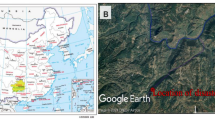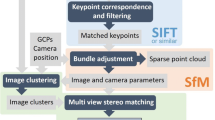Abstract
Application of unmanned aerial vehicles (UAVs) for civil infrastructure monitoring has gained impetus owing to the advancement of aerial platforms paralleled with the development of sophisticated sensors. Photogrammetry is the science of measuring distances from two or more images, and close-range photogrammetry (CRP) is a part of photogrammetry that involves calculating measurements of an object within a maximum distance of 305 m away from the inspecting sensors. Geotechnical problems including differential heaving and related cracking of expansive soils cause extensive damage to pavement infrastructure. Feasibility of using UAV–CRP technology in health monitoring of pavement infrastructure constructed over problematic soils has been comprehensively studied, and this paper presents an overview of these results. Pavement performance data including longitudinal and transverse slopes, as well as distress conditions such as pavement surface cracking, pothole formation, and rutting or excessive deformation, are monitored via UAV–CRP technology, and these data sets are comprehensively analysed. UAV–CRP-interpreted performance indicators showed a very good agreement with those obtained from traditional methods surveys and profiler studies. With the further research, the UAV–CRP technology will play an important engineering role in safe, inexpensive and comprehensive health monitoring of infrastructure built over problematic soil conditions.










Similar content being viewed by others
References
Asphalt Pavement Construction—Asphalt Institute Asphalt Institute. http://www.asphaltinstitute.org/engineering/frequently-asked-questions-faqs/asphalt-pavement-construction/. Accessed 22 Jul 2018
Mustaffara M, Lingb TC, Puanb OC (2008) Automated pavement imaging program (APIP) for pavement cracks classification and quantification—a photogrammetric approach. Int Arch Photogramm Remote Sens Spat Inf Sci 37:367–372
Colomina I, Molina P (2014) Unmanned aerial systems for photogrammetry and remote sensing: a review. ISPRS J Photogramm Remote Sens 92:79–97
Udin WS, Ahmad A (2014) Assessment of photogrammetric mapping accuracy based on variation flying altitude using unmanned aerial vehicle. In: IOP conference series: earth and environmental science. IOP Publishing, p 12027
Wen M-C, Kang S-C (2014) Augmented reality and unmanned aerial vehicle assist in construction management. In: 2014 international conference on computing in civil and building engineering, pp 1570–1577
Haulman DL (2003) US unmanned aerial vehicles in combat, 1991–2003. Air Force Historical Research Agency Maxwell AFB AL
Rathje EM, Woo K, Crawford M (2006) Spaceborne and airborne remote sensing for geotechnical applications. In: GeoCongress 2006: geotechnical engineering in the information technology age, pp 1–19
Pereira E, Bencatel R, Correia J et al (2009) Unmanned air vehicles for coastal and environmental research. J Coast Res 56:1557–1561
Tahar KN, Ahmad A (2012) A simulation study on the capabilities of rotor wing unmanned aerial vehicle in aerial terrain mapping. Int J Phys Sci 7:1300–1306
Suncar OE, Rathje EM, Buckley SM (2013) Deformations of a rapidly moving landslide from high-resolution optical satellite imagery. In: Geo-congress 2013: stability and performance of slopes and embankments III, pp 269–278
Adu-Gyamfi YO, Tienaah T, Attoh-Okine NO, Kambhamettu C (2014) Functional evaluation of pavement condition using a complete vision system. J Transp Eng 140:4014040
Shamsabadi SS, Wang M, Birken R (2014) PAVEMON: a GIS-based data management system for pavement monitoring based on large amounts of near-surface geophysical sensor data. In: 27th annual symposium on the application of geophysics to engineering and environmental problems (SAGEEP)
Puppala AJ, Talluri N, Congress SSC, Gaily A (2018) Ettringite induced heaving in stabilized high sulfate soils. Innov Infrastruct Solut 3:72. https://doi.org/10.1007/s41062-018-0179-7
Congress SSC (2018) Novel infrastructure monitoring using multifaceted unmanned aerial vehicle systems–close range photogrammetry (UAV–CRP) data analysis. Doctoral thesis, University of Texas Arlington, pp 1–394. http://hdl.handle.net/10106/27746. Accessed 26 Feb 2019
Congress SSC, Puppala AJ (2019) Novel methodology of using aerial close range photogrammetry technology for monitoring the pavement construction projects. Airf Highw Pavements 2019:121–130
Puppala AJ, Congress SSC, Talluri N, Wattanasanthicharoen E (2019) Sulfate-heaving studies on chemically treated sulfate-rich geomaterials. J Mater Civ Eng 31:4019076
Stallings SL (1999) Roadside ditch design and erosion control on Virginia Highways. Master’s thesis, Virginia Polytechnic Institute and State University, pp 1–170
Manosuthikij T (2008) Studies on volume change movements in high PI clays for better design of low volume pavements. Doctoral thesis, University of Texas Arlington, pp 1–283. http://hdl.handle.net/10106/1139. Accessed 26 Feb 2019
Siebert S, Teizer J (2014) Mobile 3D mapping for surveying earthwork projects using an unmanned aerial vehicle (UAV) system. Autom Constr 41:1–14
Puppala AJ, Congress SSC, Bheemasetti TV, Caballero SR (2018) Visualization of civil infrastructure emphasizing geomaterial characterization and performance. J Mater Civ Eng 30:04018236. https://doi.org/10.1061/(ASCE)MT.1943-5533.0002434
Rathinam S, Kim ZW, Sengupta R (2008) Vision-based monitoring of locally linear structures using an unmanned aerial vehicle. J Infrastruct Syst 14:52–63
Lin Y, Saripalli S (2012) Road detection and tracking from aerial desert imagery. J Intell Robot Syst 65:345–359
Irizarry J, Gheisari M, Walker BN (2012) Usability assessment of drone technology as safety inspection tools. J Inf Technol Constr 17:194–212
Smith DL, Abdullah QA, Maune D, Heidemann KH (2014) ASPRS slide presentation, final version for Board Submital. https://www.asprs.org/news-resources/asprs-positional-accuracy-standards-for-digital-geospatial-data. Accessed 11 Aug 2018
Congress SSC, Puppala AJ, Lundberg CL (2018) Total system error analysis of UAV–CRP technology for monitoring transportation infrastructure assets. Eng Geol. https://doi.org/10.1016/J.ENGGEO.2018.11.002
Agisoft PhotoScan. http://www.agisoft.com/. Accessed 22 July 2018
Sayers MW, Karamihas SM (1998) The little book of profiling. University of Michigan 705
AASHTO PP 69 (2016) Determining pavement deformation parameters and cross slope from collected transverse profiles. https://infostore.saiglobal.com/en-us/standards/aashto-pp-69-2016-1236_SAIG_AASHTO_AASHTO_2980/. Accessed 17 Oct 2018
AASHTO PP 70-10. https://www.techstreet.com/standards/aashto-pp-70-10?product_id=1743807. Accessed 22 July 2018
Puppala AJ, Manosuthkij T, Nazarian S, Hoyos LR (2011) Threshold moisture content and matric suction potentials in expansive clays prior to initiation of cracking in pavements. Can Geotech J 48:519–531
M AE 1703/E (2005) Standard test method for measuring rut-depth of pavement surfaces using a straightedge
Acknowledgements
The authors would also like to thank the TxDOT for granting the funds for Research Project 06944 and NSF for funding the Award Number 1760715 (Program Directors: Jonathan Sprinkle and David Corman of CISE, NSF). The authors would like to express their sincere appreciation to the TxDOT research team Joe Adams, Jonathan Martin, Arturo Perez, Wade Blackmon and John Vasquez for providing assistance during data collection. The authors would like to acknowledge the University of Texas Arlington team members Cody Lundberg, Ujwalkumar Patil, Tejo Vikash Bheemasetti, Ali Shafikhani and He Shi for their help during data collection. The authors gratefully acknowledge the support and generosity of the Center for Transportation Equity, Decisions and Dollars (CTEDD) for its partial support towards this work.
Author information
Authors and Affiliations
Corresponding author
Additional information
Publisher's Note
Springer Nature remains neutral with regard to jurisdictional claims in published maps and institutional affiliations.
Rights and permissions
About this article
Cite this article
Congress, S.S.C., Puppala, A.J. Evaluation of UAV–CRP Data for Monitoring Transportation Infrastructure Constructed over Expansive Soils. Indian Geotech J 50, 159–171 (2020). https://doi.org/10.1007/s40098-019-00384-4
Received:
Accepted:
Published:
Issue Date:
DOI: https://doi.org/10.1007/s40098-019-00384-4




